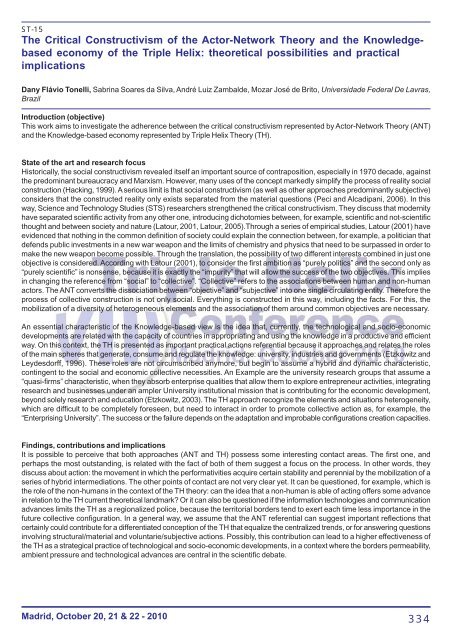TRIPLE HELIX noms.pmd
TRIPLE HELIX noms.pmd
TRIPLE HELIX noms.pmd
Create successful ePaper yourself
Turn your PDF publications into a flip-book with our unique Google optimized e-Paper software.
ST-15The Critical Constructivism of the Actor-Network Theory and the Knowledgebasedeconomy of the Triple Helix: theoretical possibilities and practicalimplicationsDany Flávio Tonelli, Sabrina Soares da Silva, André Luiz Zambalde, Mozar José de Brito, Universidade Federal De Lavras,BrazilIntroduction (objective)This work aims to investigate the adherence between the critical constructivism represented by Actor-Network Theory (ANT)and the Knowledge-based economy represented by Triple Helix Theory (TH).State of the art and research focusHistorically, the social constructivism revealed itself an important source of contraposition, especially in 1970 decade, againstthe predominant bureaucracy and Marxism. However, many uses of the concept markedly simplify the process of reality socialconstruction (Hacking, 1999). A serious limit is that social constructivism (as well as other approaches predominantly subjective)considers that the constructed reality only exists separated from the material questions (Peci and Alcadipani, 2006). In thisway, Science and Technology Studies (STS) researchers strengthened the critical constructivism. They discuss that modernityhave separated scientific activity from any other one, introducing dichotomies between, for example, scientific and not-scientificthought and between society and nature (Latour, 2001, Latour, 2005).Through a series of empirical studies, Latour (2001) haveevidenced that nothing in the common definition of society could explain the connection between, for example, a politician thatdefends public investments in a new war weapon and the limits of chemistry and physics that need to be surpassed in order tomake the new weapon become possible. Through the translation, the possibility of two different interests combined in just oneobjective is considered. According with Latour (2001), to consider the first ambition as “purely politics” and the second only as“purely scientific” is nonsense, because it is exactly the “impurity” that will allow the success of the two objectives. This impliesin changing the reference from “social” to “collective”. “Collective” refers to the associations between human and non-humanactors. The ANT converts the dissociation between “objective” and “subjective” into one single circulating entity. Therefore theprocess of collective construction is not only social. Everything is constructed in this way, including the facts. For this, themobilization of a diversity of heterogeneous elements and the association of them around common objectives are necessary.An essential characteristic of the Knowledge-based view is the idea that, currently, the technological and socio-economicdevelopments are related with the capacity of countries in appropriating and using the knowledge in a productive and efficientway. On this context, the TH is presented as important practical actions referential because it approaches and relates the rolesof the main spheres that generate, consume and regulate the knowledge: university, industries and governments (Etzkowitz andLeydesdorff, 1996). These roles are not circumscribed anymore, but begin to assume a hybrid and dynamic characteristic,contingent to the social and economic collective necessities. An Example are the university research groups that assume a“quasi-firms” characteristic, when they absorb enterprise qualities that allow them to explore entrepreneur activities, integratingresearch and businesses under an ampler University institutional mission that is contributing for the economic development,beyond solely research and education (Etzkowitz, 2003). The TH approach recognize the elements and situations heterogeneity,which are difficult to be completely foreseen, but need to interact in order to promote collective action as, for example, the“Enterprising University”. The success or the failure depends on the adaptation and improbable configurations creation capacities.Findings, contributions and implicationsIt is possible to perceive that both approaches (ANT and TH) possess some interesting contact areas. The first one, andperhaps the most outstanding, is related with the fact of both of them suggest a focus on the process. In other words, theydiscuss about action: the movement in which the performativities acquire certain stability and perennial by the mobilization of aseries of hybrid intermediations. The other points of contact are not very clear yet. It can be questioned, for example, which isthe role of the non-humans in the context of the TH theory: can the idea that a non-human is able of acting offers some advancein relation to the TH current theoretical landmark? Or it can also be questioned if the information technologies and communicationadvances limits the TH as a regionalized police, because the territorial borders tend to exert each time less importance in thefuture collective configuration. In a general way, we assume that the ANT referential can suggest important reflections thatcertainly could contribute for a differentiated conception of the TH that equalize the centralized trends, or for answering questionsinvolving structural/material and voluntarie/subjective actions. Possibly, this contribution can lead to a higher effectiveness ofthe TH as a strategical practice of technological and socio-economic developments, in a context where the borders permeability,ambient pressure and technological advances are central in the scientific debate.Madrid, October 20, 21 & 22 - 2010334










